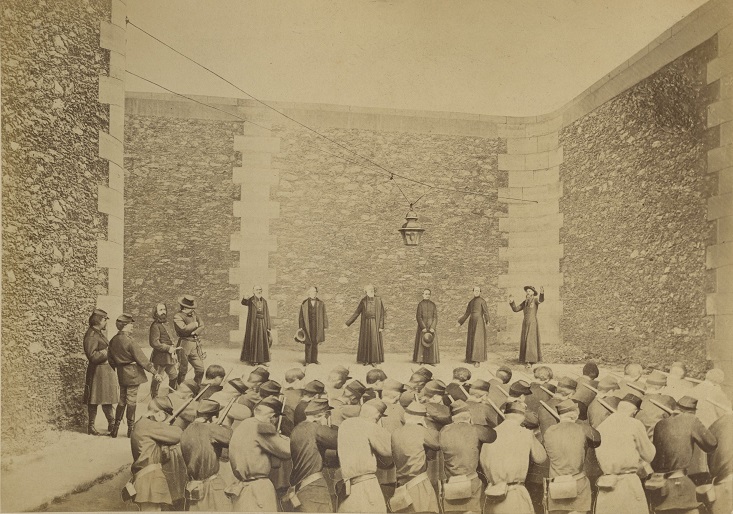May 26th - Peter Olivaint, John Caubert, Anatole de Bengy, SJ
S.G. PETER OLIVAINT: February 22, 1816
S.G. JOHN CAUBERT: July 20, 1811
S.G. ANATOLE de BENGY: September 19, 1824
All Died: 26 May 1871
 Peter Olivaint was born in Paris. His father was a retired military officer and both his parents were unbelievers although they had him baptized as an infant. At twenty Peter left home and studied at the College Charlemagne, where he excelled in his studies and was imbued with the doctrines of Voltaire. His heart, however, had remained remarkably pure and in one of his writings he said: “I desire, if by any possibility I should become a priest, to be a missionary, and if I am a missionary to be a martyr” In 1836, Peter received a scholarship at the famous Normal School where he learned about the Catholic faith and developed an interest in religion. In 1835 he eagerly followed the sermons of Fr Lecordaire, the famous Dominican preacher which led him to make his profession of faith to Fr Ravignan in 1837. He was soon instrumental in forming a Catholic group which by its piety and charity soon attracted attention and respect. The Conferences of St Vincent de Paul attracted the élite of the schools and Peter with twelve of his companions established them in the parish of Saint Menard. By the ardour of their charity and faith, these heroic youths symbolized the religious renaissance in France. In 1836, Peter heard that Fr Lecordaire, was going to restore the Dominican Order in France. Several of his friends had already decided to follow the great orator and although Peter wished to follow him also, he was detained by the duty of supporting his mother. After a year of professorship at Grenoble, he returned to Paris, and occupied the chair of history at Bourbon College; in 1841 he accepted a position as tutor to the young son of the duke of La Rochefoucauld-Liancourt.
Peter Olivaint was born in Paris. His father was a retired military officer and both his parents were unbelievers although they had him baptized as an infant. At twenty Peter left home and studied at the College Charlemagne, where he excelled in his studies and was imbued with the doctrines of Voltaire. His heart, however, had remained remarkably pure and in one of his writings he said: “I desire, if by any possibility I should become a priest, to be a missionary, and if I am a missionary to be a martyr” In 1836, Peter received a scholarship at the famous Normal School where he learned about the Catholic faith and developed an interest in religion. In 1835 he eagerly followed the sermons of Fr Lecordaire, the famous Dominican preacher which led him to make his profession of faith to Fr Ravignan in 1837. He was soon instrumental in forming a Catholic group which by its piety and charity soon attracted attention and respect. The Conferences of St Vincent de Paul attracted the élite of the schools and Peter with twelve of his companions established them in the parish of Saint Menard. By the ardour of their charity and faith, these heroic youths symbolized the religious renaissance in France. In 1836, Peter heard that Fr Lecordaire, was going to restore the Dominican Order in France. Several of his friends had already decided to follow the great orator and although Peter wished to follow him also, he was detained by the duty of supporting his mother. After a year of professorship at Grenoble, he returned to Paris, and occupied the chair of history at Bourbon College; in 1841 he accepted a position as tutor to the young son of the duke of La Rochefoucauld-Liancourt.
Peter finally decided to enter the novitiate at Laval on May 2, 1845 which was hard for his mother to accept as she was still an unbeliever. After his novitiate at Laval was closed due to governmental pressure he moved to the novitiate at Vannes in Britanny and later to Brugelette in Belgium where he made his first vows, and was ordained after he completed his theology on September 21, 1850. After his ordination Fr Olivaint remained in Paris until May 3, 1852 when he was asked to teach at the College of Vaugirard, of which the Jesuits had accepted charge. He was to spend thirteen years here, first as professor and prefect of studies, and then as rector. A model teacher, he trained the heart as well as the mind, and by his exhaustless energy, added to the direction of his college many works of zeal, among others, “Society of St Francis Xavier” , initiated the Work of the Christ Child and also prepared the poor and homeless girls living in various hospices for their First Communion. After twenty-five years devoted to teaching, Father Olivaint was named Superior of the House in Paris in 1965. He accepted this burden with courage, and displayed an unbounded zeal. An indefatigable preacher and director, he exercised by his sanctity, an irresistible influence over all he met. His mother yielded to him, and under his direction Madame Olivaint prepared, by a life of prayer, for a very holy death.
The most formidable danger pending was the commune and Fr Olivaint was ready to offer his life. His wish came true because when the communards arrived to take possession of the house on the Rue de Sevres, he quietly gave himself up. Two days after they executed Mgr Darboy and five other prisoners on 24 April, Fr Olivaint with fifty-two prisoners were dragged through Paris and massacred in the Rue Haxo, just a day before the commune was overthrown. The remains of Father Olivaint and the four Jesuits who were martyred with him (Fathers Ducoudray, Caubert, Clerc, and de Bengy) were placed in a chapel in the Rue de Sèvres, where the faithful still continue to invoke them, and numberless graces have been attributed.
John Caubert was born in Paris. After studying at the College of Louis the Great he went on for a law degree. After practicing law for seven years he entered the novitiate at Saint-Acheul on July 11, 1845 and after taking his vows on July 31, 1847 at the age of thirty-six he spent a year doing philosophy and another three years in theology, he was ordained in 1851. He was confessor to the seminarians at Blois for three years after his ordination and a teacher at St Genevieve in Paris for the next seven years. In 1861 he took office as province treasurer and was living at Rue de Sevres, where he and Fr Olivaint were arrested and subsequently martyred on May 26, 1871.
Anatole de Benge was born at Bourges, France. He spent nine years in residence at the Jesuit school at Brugelette in Belgium, entered the Society at the Roman novitiate of Sant’ Andrea on November 12, 1845. After he took his vows he returned to Brugelette for four more years to do philosophy, theology and teaching before he was ordained in 1854.He then worked in several colleges in France until 1856 when he was made chaplain to the French army during the Crimean War until 1870, when he devoted his life to college work. When the Franco-Prussian War broke out, he again sought and obtained the post of chaplain. Fr de Benge rendered signal service to the sick and wounded during the siege of Paris. After the war he retired to St Genevieve to resume his work as professor and it was there while tending to the sick and wounded that he and eleven other Jesuits were arrested in the early morning of April 4, 1871 as hostages of the commune. Fr de Bengy cheered his companions during the dark days of anticipated death. On Friday, 26 May, with two Jesuit companions and some forty other victims, he was led to the court of the Cité Vincennes, Rue Haxo, where he met his death joyfully amid the frenzied shouts of the maddened Communards.
When the liberating forces emptied the prisons of all hostages on May 27, 1871 they found Fr Olivaint’s body with a gunshot wound in his chest. Fr Caubert was unrecognizable except for the crucifix he carried about his neck, and Fr de Benge was severely slashed by sabres and bayonets. Their bodies together with those of Frs Ducoudray and Clerc, were taken to the residence on Rue de Sevres and placed in the chapel of the Japanese martyrs and later, on May 31 was buried in the cemetery at Mont-Parnasse. Two months later their bodies were brought back to the church on Rue de Sevres and interred in the martyrs’ chapel.
The cause of Frs Peter Olivaint, John Caubert, Anatole de Bengy together with that of Frs Leo Ducoudray and Alexis Clerc, was introduced in Rome on February 17, 1937
